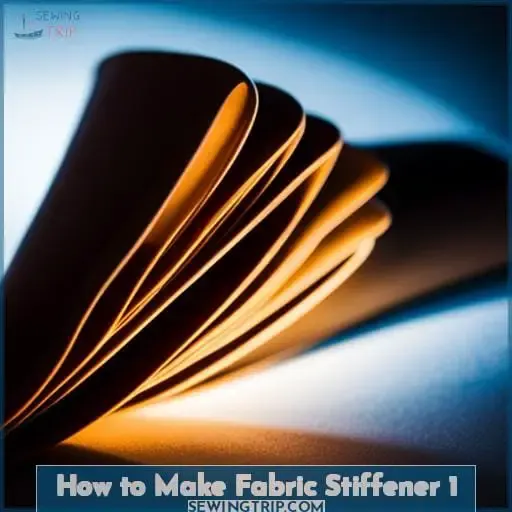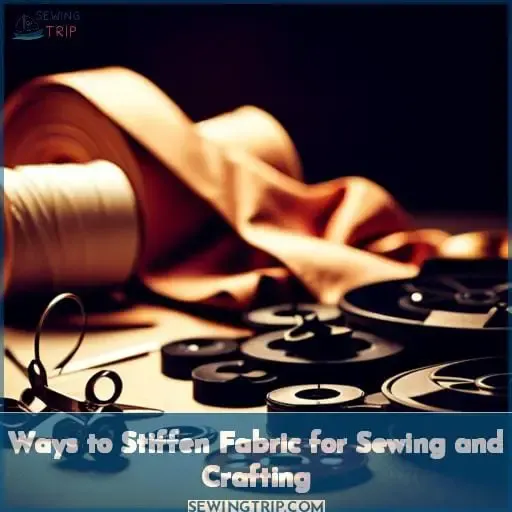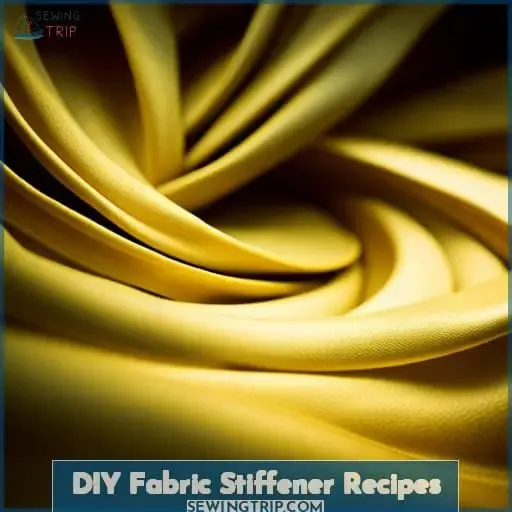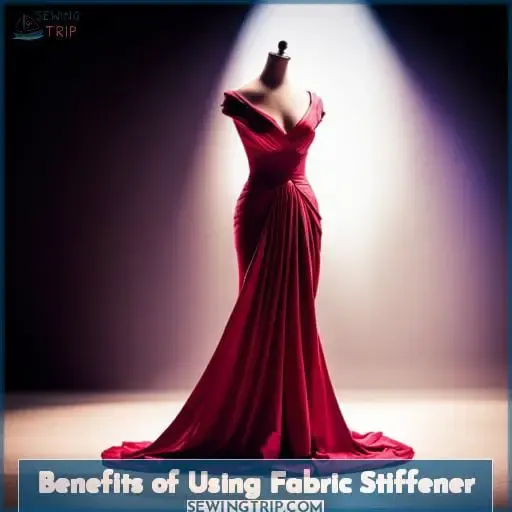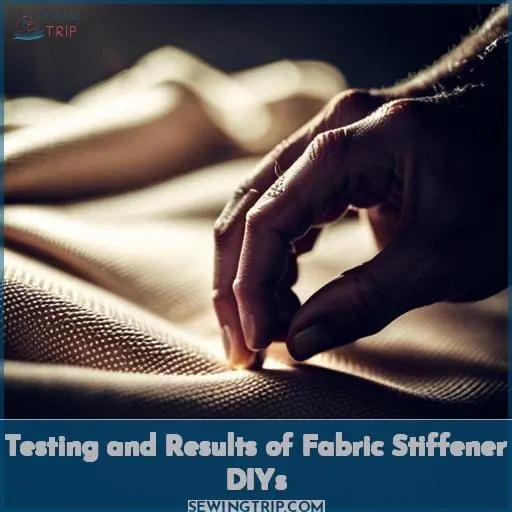This site is supported by our readers. We may earn a commission, at no cost to you, if you purchase through links.
 Aspiring crafters, if you’re looking for a way to make fabric stiffer than granite – without resorting to ancient techniques that belong in the history books – then look no further! It’s time to learn how you can make your own fabric stiffener at home.
Aspiring crafters, if you’re looking for a way to make fabric stiffer than granite – without resorting to ancient techniques that belong in the history books – then look no further! It’s time to learn how you can make your own fabric stiffener at home.
With our simple DIY recipes and tests, it’s easy as pie (not literally) to get the stiffness of your dreams with just a few ingredients and some know-how. We’ll walk through everything from tried-and-true methods like using interfacing or glue, all the way up to homemade cornstarch or gelatin recipes.
Plus, we’ll cover why this is such an important step for any sewing project; easier cutting, smoother pressing.
So don’t wait another minute: let’s start making fabric stiffener now!
Table Of Contents
Key Takeaways
- Fabric stiffeners can be made at home using DIY recipes and household ingredients.
- Different methods of stiffening fabric have varying effects and levels of rigidity.
- Fabric stiffeners can be used in sewing, crafting, and art projects to achieve the desired stiffness and 3D effects.
- Experimentation is key in finding the right fabric stiffener for a project.
How to Make Fabric Stiffener
You can stiffen fabric with interfacings, boning, spray, or hand-applied liquid stiffeners for crafts, and even your own DIY recipes using household ingredients – so let’s get creative!
Using interfacing is a simple way to add structure to fabrics like cotton; just make sure you choose the right type of fusible.
Boning techniques are an old-fashioned way of adding stiffness and support by inserting stays between two layers of fabric.
Starch mixtures are also a popular choice when it comes to making things hold their shape better – this ancient method has been used for centuries!
Gelatine solutions work great too – mix in some unflavored gelatine powder into boiling water until it’s dissolved completely before brushing onto the desired area.
Commercial sprays such as PVA glue can be applied directly on fabric surfaces for added body and stiffness, as well as craft projects that need extra fortification from drooping over time.
And don’t forget about those commercial products like Modge-Podge that were specifically designed with crafting in mind!
It doesn’t matter if you’re looking at sewing projects or simply creating art sculptures; there’s always something out there suited perfectly towards achieving your artistic vision while giving any material its much-needed 3D look thanks to the careful use of these various fabric stiffener options available today.
Ways to Stiffen Fabric for Sewing and Crafting
With so many options for making fabric stiffener, it’s easy to feel overwhelmed. But if you break down the process into manageable steps, you can achieve the perfect stiffness for any project.
Using Interfacing
Interfacing is a simple way to give fabrics like cotton an extra layer of structure and support, fusing it with the fabric for a lasting effect. When choosing interfacing, consider whether you need non-fusible or two-sided fusible types.
You can apply interfacing by either ironing or using crafting spray methods. When cutting, make sure to follow grainlines. Sewing requires additional steps, such as adding trimming and topstitching along seams.
This will ensure that your fabric stiffener stays in place permanently. Commercial projects are often best suited for two-sided fusibles since they provide more stability than other options available today.
Using Boning
Boning is another method for stiffening fabric, giving it a more structured look and feel. For example, you could use boning to create an elegant corset perfect for any special occasion.
There are different types of boning that can be used depending on the desired stiffness level and style of the project. Finishing techniques, such as topstitching, should be used when installing boning to ensure it stays in place permanently.
Depending on the project ideas, there are various methods available, like freezer paper or creating your own fabric stiffener solution from common household ingredients. This allows you to test out different ideas without using costly supplies! DIY fabric stiffener recipe methods provide endless possibilities for customizing fabrics with unique designs and textures while still achieving a professional finish every time.
Using Glue
Glue is a great way to add structure and complexity to your fabric, allowing you to craft creative designs with lasting results. Stiffening techniques vary depending on the type of fabric being used. Application methods can include Aleene’s Stiffen Quick, a tablespoon of wood glue for permanent solutions, or Elmer’s Glue.
With the right combination of stiffening technique and material type, you can create beautiful pieces that stand out from the rest!
Using Starch
Starch is an easy and economical way to transform your fabric into something truly special, giving it a unique stiffness that’ll help bring your projects to life!
Preparation for using starch involves mixing the correct amount of water with a cup of cornstarch or laundry starch. This creates the perfect solution. It’s important not to use too much as this could leave behind residue that will soften when exposed to warm water—especially when washed in the second wash.
The advantages versus disadvantages should be weighed carefully before applying a particular stiffening agent. While it may look great initially, it might not last over time. Sewing studios often opt for softening results due to its long-term effects on fabrics like lace or doilies, which can become brittle if left untreated by harsher agents like glue or commercial products like Modge Podge Stiffy.
Using Gelatine
Gelatine is a great choice for fabric stiffener if you want to achieve a 3-dimensional look. Before using it, make sure it’s the right one for the job! To ensure desired stiffness levels and drying time, use boiling water with cold water in equal parts.
For extra safety precautions, use a piece of rayon to control ironing help and finishing tips before applying gelatine fabric stiffener to your project.
With proper research on materials needed and steps followed, success with gelatine as an economical alternative will not disappoint!
DIY Fabric Stiffener Recipes
If you’re looking for a way to stiffen fabric for your next sewing or craft project, DIY fabric stiffener recipes are an economical and creative choice. Cornstarch mixtures can be used as a spray-on application that gives fabrics a crisp stiffness; gelatin solutions provide lightweight support with pliability; while glue solutions help strengthen weak areas in need of extra reinforcement.
Cornstarch Fabric Stiffener
Transform fabric into a 3-D work of art with the help of cornstarch – an easy and economical stiffening solution! Create shapes, add color, and strengthen fibers without worrying about shrinkage. Start by filling up a spray bottle with water mixed with cornstarch until you reach your desired consistency.
This homemade alternative can be used instead of commercial spray stiffeners for all types of projects, from doilies to hats or skirts.
Gelatine Fabric Stiffener
Create an intricate masterpiece in any fabric you choose with the help of a gelatine stiffener! Transform fabrics into dynamic shapes and patterns that won’t shrink, while adding strength to delicate materials.
Mix water and unflavored gelatin until reaching the desired consistency, then spray or brush onto fabric before applying heat. Enjoy flexible results – reusable solutions for historical costumes or various types of interfacing without worrying about damaging your material.
Glue Fabric Stiffener
Give your fabric a unique twist with glue stiffener – an easy and budget-friendly way to craft something beautiful! Spray application of Elmer’s Glue or other adhesives is an effective method for crafting with fabric.
Different types of fabrics, such as silk organza, require durability tests to ensure the stiffening agent holds up. Washability tests are also necessary to check if it will come out after washing. Experiment with stiffness levels to find the right balance that suits your project needs best when using pieces of lightweight rayon or shifty fabrics like tulle and chiffon in combination with press cloths over them.
Benefits of Using Fabric Stiffener
Using fabric stiffener can make your sewing and crafting projects much easier. Not only does it help to stabilize materials for cutting, but it also makes them more manageable while sewing, as well as aids in better pressing of the finished product.
Stiffening agents are a great way to get professional-looking results on any craft or garment you create.
Easier Cutting
Stiffening your fabric can make cutting easier, giving you crisp edges and precise shapes with every snip. It also helps create a stronger bond between the fibers for improved durability, allowing you to work faster while achieving a smoother finish.
This is especially true when using Milwaukee-area target fabrics in the sewing scene or taking advantage of commercial spray stiffeners.
By experimenting with different techniques, you’ll find what works best for your project needs without sacrificing quality or precision.
Easier Sewing
By stiffening your fabric, you can make sewing easier and faster – with no sacrifice in quality! With the right stiffening agents, pressing becomes a breeze for any fabric type. Plus, it provides a stiffer finish to the side of the web that will show when finished.
Whether working on your latest crafting project or using a hand-applied liquid such as starch or glue – even spray hairspray works great too – you’ll have an improved end result in terms of look and feel.
Experimentation is key to success. By trial-and-erroring different techniques, you’ll find what works best for each job at hand without sacrificing precision or performance!
Easier Pressing
With the right stiffening agents, pressing your fabric can become a breeze – providing you with an improved end result in terms of look and feel without sacrificing precision or performance. For best results, choose heat settings that match the stiffness level desired for each project and use ironing techniques accordingly.
Spray methods are often easier than hand-applied liquid solutions like starch or glue because they save time while still delivering great results.
Testing fabric-stiffening solutions such as cornstarch is highly recommended to get comfortable with how it works before taking on bigger projects like hats, skirts, lacework pieces, and more! With practice comes confidence, which will lead to beautiful creations every single time!
Testing and Results of Fabric Stiffener DIYs
Testing fabric stiffener DIYs can be an exciting and rewarding experience. Washing and drying details, cornstarch fabric stiffener, gelatin fabric stiffener, glue fabric stiffener – all these methods should be tested carefully for best results.
Washing and Drying Details
When washing projects stiffened with interfacing, boning, or DIY recipes, take extra care to ensure that the results you achieved are not lost. The fabric type and stiffness levels will determine how long a project should soak in water before going into the washing machine.
Generally, no more than 20 minutes is recommended for a pre-soak, but experimentation may be necessary depending on your sewing experience and chosen stiffener recipe.
Fabric must also be dried carefully, as heat can damage some fabrics that have been treated with one of these agents. Ideally, air drying is best to preserve its shape and stiffness level without risking shrinking or discoloration due to excessive heat exposure.
Be sure to refer back often throughout this process so your hard work does not wash away!
Cornstarch Fabric Stiffener
Try using cornstarch for a fabric stiffener—it can help give your projects a 3-dimensional look that’s often more cost-effective than commercial options. It also has the added benefit of being easy to use, with many DIY recipes calling for common household ingredients like water and cornstarch.
Molding techniques will allow you to create unique shapes depending on the desired rigidity levels, while stiffness tests will let you know when optimal results have been achieved.
Gelatine Fabric Stiffener
You can achieve a unique look with gelatine fabric stiffener, which is often used in crafting and costuming to create permanent structures that hold their shape. Moldable lacework or burlap flowers are ideal for wreath making or creating historical costumes.
Different applications require different techniques – try using a piece of lightweight rayon as your sewing hero! Elmer’s glue makes an excellent alternative to commercial stiffening agents, but be sure to experiment until you find the right combination for your project.
With these tips and tricks up your sleeve, achieving beautiful results with fabric stiffeners will become second nature!
Glue Fabric Stiffener
Discover the unique look you can create with glue fabric stiffener – a retro favorite for crafting and costuming.
The aesthetics are unmatched when using glue-stiffened fabrics. From hats to skirts, burlap flowers to lacework, there’s something for everyone. It’s easy enough to whip up your own concoction at home too – just mix Elmer’s Glue with water in varying ratios depending on how stiff you want the fabric.
Pros? You have complete control over the outcome and won’t be stuck paying for expensive commercial products or worrying about cons like washability.
Away!
Frequently Asked Questions (FAQs)
What is the difference between interfacing and boning for stiffening fabric?
Interfacing is a permanent fabric stiffener used for structural and decorative support in sewing projects, while boning provides a more rigid structure. Both are effective for creating desired shapes; however, the former will remain even after washing, unlike the latter which may be washed out.
Figuratively speaking, interfacing is like a backbone that offers subtle yet strong support.
What are the most common types of fabric stiffeners used in crafting?
Experience crafting with diverse fabric stiffeners: glue, starch, gelatin, and commercial products like Mod Podge. Create beautiful art sculptures, wreaths, and flowers from burlap or lacework sealed with strong molds and a stiffening agent.
How do I know which fabric stiffener is the best for my project?
Discover the best fabric stiffener for your project by experimenting with various kinds of interfacing, boning, glue, starch, gelatin, and commercial products. Try out each one in different ways to find the right combination of strength and flexibility you need! Be creative – explore unique techniques like molding burlap into shapes or giving ribbons a 3D look.
Are fabric stiffeners permanent or do they wash out?
The fabric stiffener you choose depends on what you need – some are permanent, while others will wash out. With careful experimentation and a little creativity, your project can take shape like the wings of a butterfly unfurling in flight.
What kind of fabrics can be stiffened with fabric stiffeners?
Fabrics like cotton, silk, and polyester can all be stiffened with fabric stiffeners. Interfacing or boning is often used in sewing projects, while sprays with glue, starch, gelatin, or commercial products are good for crafts.
Stiffening agents can make fabrics permanent or washable, depending on the type you choose.
Conclusion
In conclusion, fabric stiffener can be used for a variety of craft projects and sewing projects, offering a range of benefits. It’s a great way to add depth and dimension to your fabric creations, and with a bit of experimentation, you can get the perfect stiffness for any project.
Like a chameleon, fabric stiffener can adapt to almost any situation, making it a must-have for any sewer or crafter.

